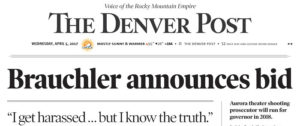The electronic signs above Colorado highways offer a warning to drivers who reach for their cellphones: “New texting law fines increased to $300.”
What it doesn’t mention: Texting while driving is now legal in Colorado as long as it isn’t done in “a careless or imprudent manner.”
The little-noticed provision softening the state’s standard is part of a new law that increased the penalties for a texting while driving carelessly citation from $50 to $300 and from one to four points on a driver’s license.
Before now, any text messaging or manual data entry by a motorist was prohibited. “The simple fact is that if you are texting while driving but not being careless, it’s no longer illegal,” said Tim Lane at the Colorado District Attorneys’ Council.
The weaker standard comes even as Colorado officials warn about an “epidemic of distracted driving” and other states are moving to toughen their laws to discourage cellphone use by motorists.
Maile Gray, the executive director of Drive Smart Colorado, a traffic safety education organization, hopes the increased fine and additional points on a license for first-time offenses will help curb texting while driving.
But she said she is concerned Colorado is sending the wrong message, calling the new standard “a problem.”
“What I find is most people just think they aren’t going to get caught, so they continue to (text) — and for the most part, they are right,” she said.
The state lawmakers who made the changes — and the law enforcement agencies that supported the move — argue the tougher penalties will deter texting while targeting the most dangerous drivers.
“The focus of the law isn’t for people who are stopped at stop lights or pulled over on the road texting,” said Mike Phibbs, the legislative chair for the Colorado Association of Chiefs of Police. “I think it’s actually helped clarify the issue and targets what’s really causing the problem.”
But officials acknowledge that it is now harder to issue citations to drivers for texting while driving — and that the law opens the door to more legal challenges in court.
The new law is the product of legislative dealmaking. State Sen. Lois Court, D-Denver, sponsored a bill to increase the penalty to $500, but Republicans in the GOP-led chamber initially balked.
To win passage, Court needed support from Sen. Owen Hill, R-Colorado Springs, who opposed the original texting-while-driving bill because it went too far. Hill, who is running for Congress, agreed to support the measure if it softened the language about enforcement.
If you are stuck in traffic, he said, it shouldn’t be a crime to send a text message to a spouse that you are running late. But if you’re driving carelessly, Hill continued, “you’re putting everyone else in danger and you pay the price.”
What to know about the new texting-while-driving law
Colorado lawmakers kept intact the current ban on cellphone use of any kind — talking or texting — for drivers under age 18. The fine for those infractions remains $50 for the first offense and $100 for the second offense.
What changed is how texting while driving is enforced for everyone else. The new law creates a two-part test before law enforcement can issue a citation.
First, the officers must see the driver typing on the phone — witness statements from other motorists don’t suffice.
Second, the officer must observe careless driving, which is defined in law as operating a car “without due regard for the width, grade, curves, corners, traffic and use of the streets and highways and all other attendant circumstances,” such as weather conditions.
The question about what constitutes careless driving — a class 2 misdemeanor traffic offense — is generally at the discretion of the law enforcement officer. Typically, it involves one or more traffic infractions at the same time, such as drifting across a lane marker or not using a turn signal while speeding. Most often, the charge is issued to drivers in a traffic crash.
“Ultimately, if you are texting while driving, you are not driving carefully. There is no way to divide your attention with a cellphone or any other mobile device and safely drive,” said Colorado State Patrol Trooper Josh Lewis. “We are looking for multiple (violations), but it’s very easy to get that careless when you are texting while driving.”
Under the law, texting is defined as manual typing of any kind — entering a phone number, putting an address into the GPS or sending any electronic messages. “Anything that takes your eyes off the road, hands off the wheel,” Lewis said.
But the ambiguities in the law make it difficult to outline what behavior is now allowed. Law enforcement and criminal defense attorneys agree that texting while stopped in traffic, on the side of the road or at a stop light is permissible — as long as it doesn’t become a hazard to others.
Texting while driving down the road also is allowed — except where prohibited by local ordinance — but law enforcement officials suggest even experienced drivers can’t do it without becoming careless.
Colorado bucks trend toward tougher laws
The statistics appear to reinforce this point. The average text message takes 4.6 seconds to send or read, according to distracted driving studies. At 55 mph, a driver can travel the length of the football field in that time — essentially blindfolded.
“I think that startles people, but that’s what you are doing if you are looking down at your phone,” said Gray, the traffic safety educator.
In Colorado, transportation officials said distracted driving — which includes cellphone use — contributed to 16 percent of the injury and fatal crashes in 2015 and 26 percent of the noninjury crashes.
The preliminary 2016 numbers indicate that 67 fatal crashes involved a distracted driver, compared to 69 the year before and 58 in 2014, according to the state transportation department.
Outside Colorado, texting while driving is illegal for all drivers in 46 states — the other exceptions being Arizona, Missouri and Montana, according to the Insurance Institute for Highway Safety. In Missouri, texting is banned only for drivers 21 and younger.
In Washington state, a new texting law that takes effect in July prohibits drivers from holding a personal electronic device while driving or stopped in traffic. In Texas, which adopted a texting ban this month, reading, writing or sending an electronic message is illegal unless the vehicle is stopped.
Fourteen states take it a step further and outlaw all hand-held cellphone use.
It’s unclear how many states require a careless driving offense before a ticket is issued, but Colorado’s standard now puts it close to the handful of states that make texting while driving only a secondary offense — meaning another violation is needed before officers can enforce it.
“Compared to a lot of other states, this is not very harsh,” said Jay Tiftickjian, a defense attorney in Denver who specializes in traffic law and DUI defense. “But what it does is get the message out there to prevent people from doing it.”
The extra burden on prosecutors to prove careless driving, as well as the increase in points, could lead to more drivers challenging the tickets in court. The threshold for a suspended license is 12 points within 21 months for drivers over age 21.
“It could really affect someone’s livelihood if they had problems with points,” Tiftickjian said.
Colorado State Patrol’s Lewis said officers are enforcing the law with no grace period because the stiffer penalties are being well-advertised. But he said training for officers on how to observe and issue citations will continue as the first court cases begin to test the new standard.
“This is not anything new,” he said. Drivers “understand they cannot text and drive.”
Staff writer Jesse Paul contributed to this report.


























